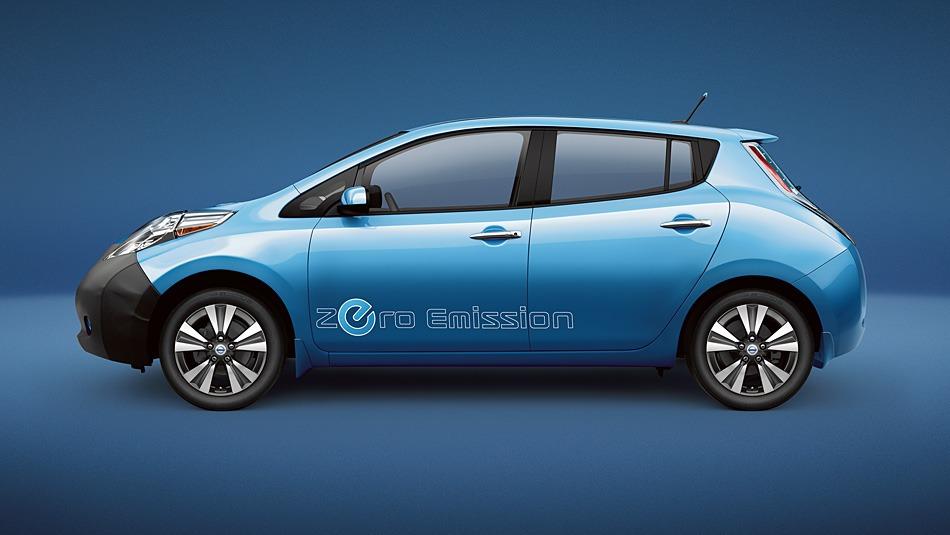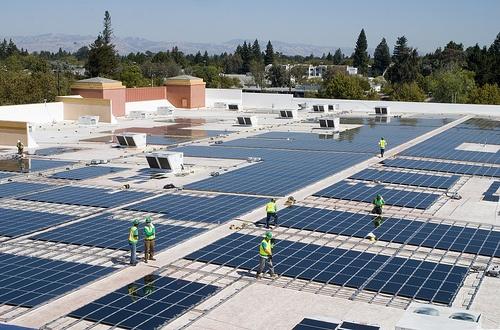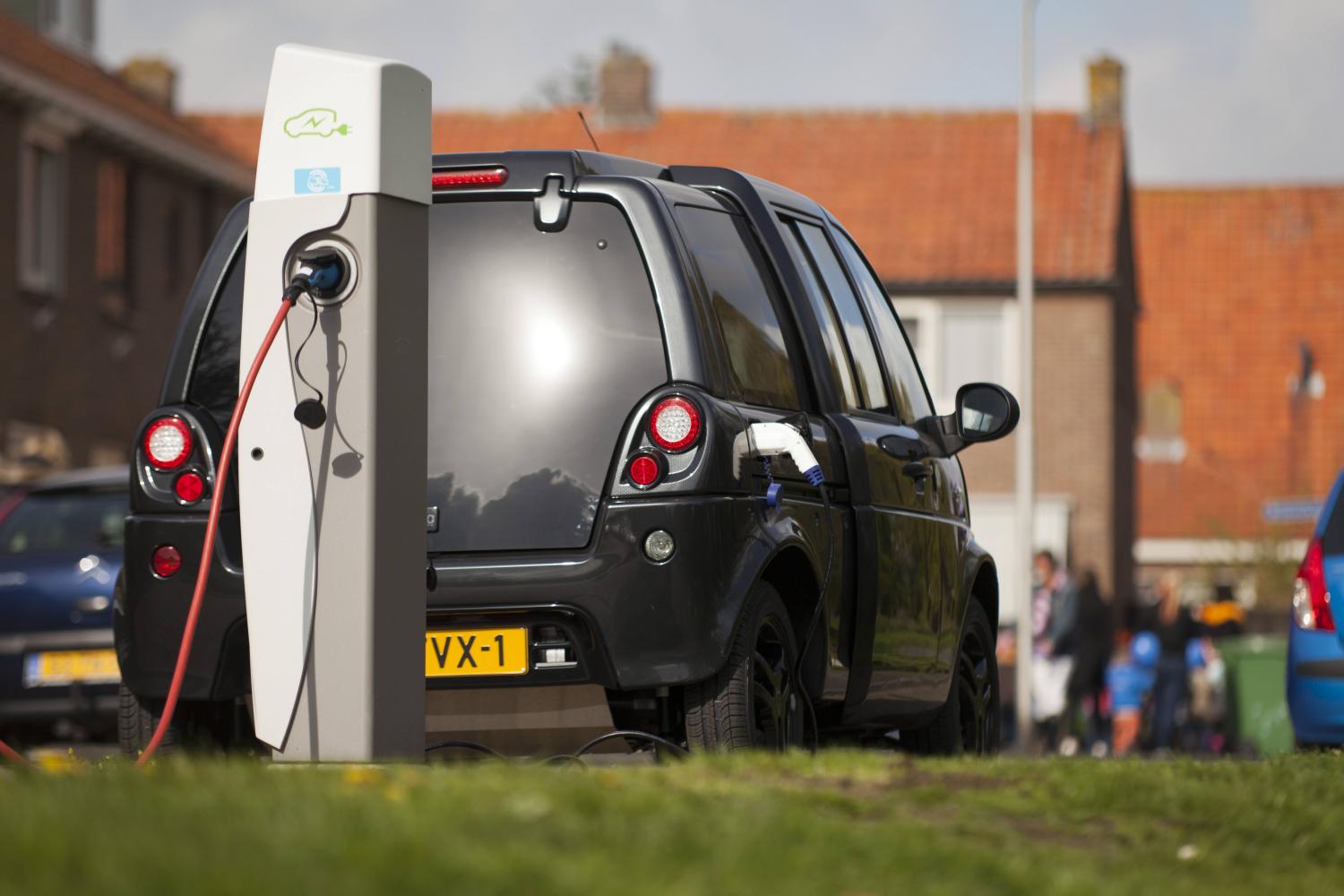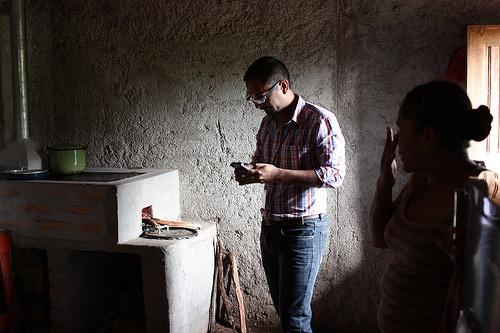Electric Vehicle Performance Found to Slide in Winter


We've all heard the saying that oil and water don't mix, but now it turns out that oil-free cars, namely EVs, and snow don't mix that well either. There have been many reports over the years that hybrids, like the Prius, don't do very well in the snow. The claims are hotly challenged by loyal Prius owners with the debate ranging from "this car is really junk in the snow," to "I have no issues with it in the snow," to "all Prius owners need in winter is a good set of winter tires."
Green Car Reports describes the issue in terms of how the traction control system operates.
The traction control sometimes works against the owner in icy conditions. The purpose of the system is to prevent wheel slip and loss of traction, but because electric motors provide maximum torque from 0 rpm, on slippery roads the wheels spin easily--whereupon the traction control promptly brakes the spinning wheel. The result, is halting acceleration with beeping from the skid alert.Refinements in more recent models have improved the situation.
But alongside the debate about handling is the added question of fuel economy. Hybrids don't do as well in winter for reasons ranging from modified winter gasoline formulations, to increased stationary warm-up time, to increased heater usage, to reduced battery performance in cold weather.
A recent report in MIT Technology Review claims that the situation gets even worse when moving from hybrids to all-electrics. Both types of vehicles share the issue of battery capacity being reduced in cold weather. “Cold temperatures primarily affect how quickly the energy can be taken out of the battery or put back in—that is, how much power it can deliver for acceleration, and how quickly it can be recharged,” according to the article. Some manufacturers, like Nissan, put an electric heater beside the battery to maintain its internal temperature, but that's not without its cost. This heater will also drain the battery, reducing the car's effective range.
Then of course, there is the cabin heater. In “normal” internal combustion vehicles, excess heat is pulled from the engine and passed through a heat exchanger, providing essentially free heat to the cabin. In the case of an EV, there is no engine, and therefore an electric heater is often used to warm the cabin, which further drains the battery. Of course the electric motors do generate a small amount of heat, and in the case of the Tesla, this heat is used, in winter, to warm the battery.
The reduced rate at which the vehicle can be recharged also comes into play when the regenerative braking is deployed. Regenerative braking uses energy extracted from the vehicle's momentum to recharge the battery. This contributes to the vehicle's overall efficiency, reducing energy consumption by as much as 10 to 25 percent. But since the battery cannot recharge as quickly when it's cold, the regenerative braking will be less effective in winter as well.
The MIT article describes several measures that are being pursued to address the situation. Researchers at Canada's Dalhousie University are investigating ways to make battery chemistry less sensitive to temperature. In particular, they are looking at ways to improve the conductivity of the electrolyte. Decreasing electrode particle size can also help, though it could raise safety issues due to their high reactivity.
As for the heater issue, some cars already use electric seat heaters, which warm the passenger rather than the cabin, but they still require additional power. The Department of Energy is funding thermal storage research. One system that is being developed for Ford behaves like a heat pump -- that can be run in reverse for cooling, using water as the refrigerant. The system can be recharged using heat, which could potentially be derived from solar, or from the electricity provided when the car is charging. This could eliminate most of the “parasitic” losses associated with heating and cooling the car. Ford hopes to have it on the market in its Focus EV within two years.
So, before we pour too much cold water on the growing enthusiasm, or snow on the EV parade, particularly among those who live up North, we need to ask how serious these cold weather drawbacks actually are.
To put this into perspective, it might be worth considering the fact that the most popular country for EVs in the world is Norway, where the average winter temperature is -1 °F. Of course, generous government incentives certainly help to improve the popularity of the vehicles. The cars are not only exempt from high purchase and value-added tax rates, but their drivers also pay no road and ferry tolls or parking fees. They also cost less to insure, can be charged up using free electricity from thousands of points and are allowed to utilize bus lanes -- a major boon in crowded cities. Local governments also subsidize the installation of charging stations in homes. The perks are estimated to be worth more than $8,200 per car, per year. Yes, that's a lot of money, but if the performance was really that bad, do you think that the Tesla Model S would be the nation's best-selling car in September and December, while the Nissan Leaf was Norway's third best-selling car for the year?
Time will tell, and of course, as the EPA says, your mileage will vary.
Image courtesy of Nissan
RP Siegel, PE, is an inventor, consultant and author. He co-wrote the eco-thriller Vapor Trails, the first in a series covering the human side of various sustainability issues including energy, food, and water in an exciting and entertaining format. Now available on Kindle.
Follow RP Siegel on Twitter.
States Reap the Benefits of US Solar Job Surge


As solar photovoltaic technology sees greater efficiency and declining levelized costs, rivaling coal, demand for solar is rising and so are the jobs. Solar industry jobs are surging throughout the United States, according to the independent nonprofit research and educational organization the Solar Foundation (TSF). Record job growth in the industry over the last year is putting people to work in communities in every region, including some unexpected ones, depending on what one expects.
For example, in the Midwest, a place some folks might believe to be too cold and cloudy for solar, the industry has seen a doubling of solar jobs since TSF last reported its numbers. Heck, the solar panel I have on my garage in Michigan puts out more wattage than it’s rated for on a sunny winter day due to increased efficiency in colder weather. There’s enormous solar potential in the Midwest, rivaling Germany in the availability of good sun…yet Germany leads the world in solar investment.
Also, Georgia, Texas, North Carolina and Louisiana combined, which some folks may consider politically hostile to renewable energy, account for nearly a quarter of solar industry job creation nationwide. If it’s a good investment, and it is, practicality tends to speak louder than philosophy.
Better established markets like those in New England saw a jump of about 50 percent, while newer markets like the aforementioned Southern states and the Midwest have generally shown a 100 percent increase. And of course, as many would expect, California and Arizona -- very sunny places -- still lead the curve in terms of absolute solar jobs, with 47,223 in California and 8,558 in Arizona.
The Solar Foundation compiled its findings into an interactive map of solar jobs organized by state. So you can check out how many of your fellow statespeople are employed in the solar boom. Michigan boasts 2,700 men and women working in this green industry, helping the state diversify from its auto-dependent rut. Nearly 4,000 have solar jobs in Ohio; 1,500 in Indiana; and so on.
Installation is by far the largest source of the solar jobs, followed by manufacturing. Also included in the jobs figures are sales and distribution, project development, and of course policy and finance jobs.
This jobs report, however, comes out in the shadow of a growing trade dispute with China which could hamper future growth. China very recently slapped large tariffs on the nation's importation of U.S. made polysilicon -- the raw materials for solar cells. This jobs report should underscore how critical it is that the U.S. take an aggressive stance to nurture this growing industry, as it's on the upswing. Real jobs and future innovation leadership are at stake.
Also posing a potential adversary of the growing solar industry, utilities may seek to curb the use of rooftop solar installations via policy. The falling price of solar and the rising popularity in rooftop installations has become a bit of an issue for public utilities who have recently identified it as a "mortal threat" to the previous utility business model. The distributed power production model posed by rooftop solar runs counter to the centralized power production the utilities' business models tend to be based on.
Solar is becoming a large driver of jobs and could easily rise to become a dominant source of clean energy in the U.S. It's already well on its way. U.S. political and business leaders would serve their communities well to keep the momentum going.
Image Credit: Walmart Corporate: Source
California Drought May Cause Higher Food Prices For All Americans


Living in rural Fresno County these days means reading about the drought in the local newspaper every day, seeing reports about it on the local news and praying for rain. The Fresno area is smack dab in the middle of California’s fertile San Joaquin Valley. It is considered to be the “agriculture center of the world.” Valley farmers supply many of the nation’s fruit and vegetables. The Valley is also home to cotton, dairy and cattle ranches. As California enters its third year of drought, farmers are hit particularly hard. Lack of water means making tough decisions, and some farmers have to idle acres of land. Some ranchers have to sell off livestock. That will affect the economy of the Valley because farming is the area’s economy.
The drought will also have effects outside of the Valley and the state. Every American may soon see higher food prices at the grocery store. Paying more for food will be hard for many, as Americans are used to lower food prices. A California Farm Water Coalition study found that Americans spend 6.2 percent less for groceries than other high-income countries. As a blog post by CFWC points out, "When water supplies are reduced, then less acres are planted and the economic theory of supply and demand takes over for the consumer’s pocketbook."
The current drought is a bad one. This is the third year of consecutive drought. This past January, the San Joaquin Valley experienced one of the driest and hottest Januarys on record. Normally, January is a cold month in the Valley when temperatures at night drop to freezing levels. Foggy mornings and nights are common. For most of this January, it was so warm that you could wear shorts and flip flops. We saw far too much of the sun. As of Feb. 6, Fresno’s total seasonal rainfall was 6.38 inches, which is 0.41 above normal, according to the Fresno Bee. However, Fresno’s rainfall for 2014 has only been 2.60 inches, which is 0.23 of an inch below average. If the rest of the rainy season, which lasts through May, bring less than average totals, the Valley will have experienced three of the driest years on record.
The drought is so serious that on Jan. 17, California Gov. Jerry Brown proclaimed a state of emergency because of it. The press release that announced the state of emergency proclamation stated that the state’s snowpack water content totals are 20 percent below the normal average for this time of year. The governor’s proclamation called for all Californians to reduce their water use by 20 percent. A few California towns, including one in the Valley, are instituting mandatory water restrictions.
Drought may become the new normal
This drought, this lack of rain in the Valley and snow in the mountains, might become the new normal. Two scientists, B. Lynn Ingram and Frances Malamud-Roam, recently released the results of their study -- which found that this type of drought we are now experiencing last occurred in 1580. The scientists made this determination by looking at tree ring patterns.
Climate change is probably playing a big role. When asked in an interview if what we’re experiencing is consistent with climate change projections for California, Ingram answered in the affirmative. Climatologist James Hansen, the one who has long warned about climate change and its effects, told Think Progress, “Increasingly intense droughts in California, all of the Southwest, and even into the Midwest have everything to do with human-made climate change."
Photo: I-5 Design & Manufacture
Greenlots Introduces Open-Standards EV Charging


Though you'll continue to read that electric vehicles have been slow to catch on, the fact is, they are catching on, and they will continue to do so. Whether it be sales of pure electric vehicles, or plug-in hybrid vehicles, the growth of electrified vehicles is necessitating the build-out of public charging infrastructure in cities, workplaces and homes.
We are familiar with the tangible parts of such infrastructure -- the electric vehicles themselves, and the physical charging stations they plug into. But to make the whole system work, you need an information technology network to connect the hardware together and manage things such as payments and connectivity to the grid, and for charging site owners, the ability to manage the infrastructure deployed.
That's where companies like Greenlots come in; a San Francisco-based global provider of open standards-based technology solutions for electric vehicle networks. On Feb. 10, the company introduced its SKY Smart Charging system, which is designed to address the needs of the utilities and vehicle-to-grid (V2G) sectors. It's a pretty esoteric part of the EV world, so I'll attempt to explain how it fits together and why it's significant.
At the outset of the deployment of EV charging infrastructure, particularly in the U.S., manufacturers of the charging station hardware built chargers with proprietary communications systems -- the messaging which allows the chargers to talk to the network platform, or the so-called "back-office." All things being well, this is fine functionally, but there is a risk that if a company goes out of business -- as Ecotality and Better Place did -- perfectly operational charging stations are in danger of becoming "stranded assets." Since the hardware is using a proprietary communications language, if the "host" goes out of business, the chargers don't talk to anybody else and become essentially useless.
Though Greenlots doesn't make chargers, its SKY Smart Charging platform supports the Open Charge Point Protocol (OCPP) -- a popular open-source communication language between the hardware and the managing network system -- allowing any charging stations that use OCPP to be interoperable with the platform. OCPP is popular in Europe already and can benefit charging site operators equally in the U.S. This is because the open-source protocol allows site owners to switch networks, without having to replace the hardware. Plus, any hardware using OCPP is not at risk of becoming stranded as described above. While Greenlots was a founding member of the Open Charge Alliance, which supports OCPP, they are not unique in adopting it.
Where Greenlots is unique, however, is with respect to another important component of SKY Smart Charging -- that of managing "automated demand response" with utilities. Greenlots' system is the first and only EV charging platform provider to receive certification for the OpenADR 2.0b protocol -- again, an open-source protocol, which allows automated demand response (that's what the ADR part means) between the utilities and the charging infrastructure.
What is demand response? Simply put, demand response provides grid stabilization by averting major problems when electricity demand, at any given moment, exceeds supply -- thereby overloading the grid. Such circumstances can occur, for example, when air conditioner usage spikes in hot summer months at certain times of the day, and of course, as sales of EVs continue, clusters of EVs can cause similar demand spikes if everyone comes home from work and plugs in at the same time. Principally, demand response is managed by offering pricing differentials to customers -- that is, higher costs at peak demand times and lower costs at off-peak times.
If site owners opt-in, OpenADR offered via Greenlots' system is able to facilitate an "automatic load curtailment," based on setting parameters such as the amount of energy, the price of energy and the strain on the grid -- thereby minimizing the impact of EV charging on the grid. It also provides the added benefit of allowing site owners to enjoy reduced electricity rates.
As such, SKY Smart Charging principally benefits two entities in particular: Site owners who can avoid stranded assets along with the ability to control costs and utilities that, through OpenADR, are able to manage the grid optimally.
While Greenlots' system brings immediate benefits today, the system is forward-looking, too. Full implementation of V2G technology is a future state where energy transfer between the grid and EVs is "bi-directional." At times, EVs will store energy from the grid, and at other times they will put energy back into the grid. Brett Hauser, Greenlots' president told me: "Our platform is set up to be able to handle the capabilities of V2G, but there are no commercial applications today."
But Greenlots plans to be part of that future. "Logically, V2G follows up after demand response -- from curtailment in one direction...then V2G would be the bi-directional capability after that." In a rapidly evolving industry, "future proofing" is an important part of the game.
Image courtesy Of Greenlots
Follow me on Twitter @PhilCovBlog
High levels of unauthorised absence ring supply chain alarm bells


A high level of unauthorised absence should ring alarm bells for retailers when assessing their suppliers as it can often indicate poor working conditions says new research from Responsible Trade Worldwide (RTW).
Rebecca Taylor, who led the research at RTW commented: “Ethical trade is currently firmly on the retail supply chain management agenda following the tragedy at the textile factory in Bangladesh.This in turn has led to an increase in demand for transparency and clarity into the working practices of the suppliers that produce consumer goods, and their journey through often convoluted global supply chains.
“Our research shows that it is critical that retailers know about operational standards from the perspective of workers across the supply chain and this requires a shift from a compliance-based approach to one which embraces greater engagement with suppliers and workers. Retailers need to get to grips with working hours, wages, company culture, environmental policies and community engagement activities of their trading partners. This will provide a more complete view of a supplier and in turn will highlight areas of risk, and inform the business case for change.”
For the full story read the March issue of Ethical Performance. Subscribe today!
Picture credit: © John Takai | Dreamstime.com
Preview: Series Launch on Sustainable Apparel Tomorrow


We are very pleased to announce the launch of a new article series - Sustainably Attired: Exploring the Lifecycle of Fashion.
Through this in-depth series, we'll spend the next four months exploring the environmental and social impact of fashion. We’ll take you through the lifecycle of fashion: from the design phase, through material procurement and product construction in a factory setting. We'll look at what it means for apparel to be "fair trade." We’ll also take a peek inside the consumer’s closet and look at how consumer demand influences the industry. Finally, we'll explore the leading second uses for worn-out garments and the future of the sustainable fashion movement as a whole.
This series comes to you with the support of lead sponsor Levi Strauss & Co., a company we've covered many times over the years for their decades of commitment to sustainable apparel. Levi Strauss & Co. takes multi-faceted approach to sustainability, highlighting consumer-focused initiatives like low-impact care tags as well as collections like Water<Less, Waste<Less and Wellthread that are as highly fashionable as they are sustainable.
The apparel manufacturer has also made headlines for their collaborative approach, working with organizations like the Better Cotton Initiative and the Sustainable Apparel Coalition to support the sustainability of the apparel industry as a whole. We're thrilled that they've decided to take the next step by supporting our editorial exploration of the topic.
In keeping with the spirit of collaboration, we've also brought in a number of other companies with sustainability baked into their business model, including: INDIGENOUS, Modavanti, Amour Vert, Appalatch, Dhana Ecokids, Threads4Thought, Mata Traders, OSMIUM, Redress Raleigh and Synergy Organics. Fair Trade USA, purveyors of the Fair Trade certification for apparel, has also offered their support. These organizations will be sharing their perspectives throughout the series.
There is no denying that sustainability in fashion is a meaty, complicated topic, with many competing priorities for brands that wish to produce sustainable fashion that consumers will want to wear. Through the course of the series, we’ll seek to unravel how brands decide where to focus and how they prioritize competing issues. We’ll examine the impact of their efforts on people and the planet, and we’ll take a look at the future of the industry. Check back here tomorrow for the first article in the series. If you miss an installment, you can catch them all here.
Image credit: Cleo Vermij/Unsplash
New Carbon Trust Report Warns Business: Adapt or Die


Citing a potential 40 percent gap between water resources and water needs by 2030, the U.K. based organization Carbon Trust has issued a new report highlighting water risk issues for business with the attention-getting pitch "adapt or die." Though somewhat alarming, the turn of phrase is timely here in the U.S., where the West Virginia chemical spill in the Elk River and the North Carolina coal ash spill in the Dan River have dramatically illustrated the consequences of lax regulation and fossil fuel dependency.
The report is also timely for U.S. businesses because a new Ceres report on fracking and water risks has turned up the heat on water resource issues.
Rather than dwelling on risks, though, the Carbon Trust report is all about solutions and opportunities, as you can gather by the title "Opportunities in a resource constrained world: How business is rising to the challenge."
The Carbon Trust report
The Carbon Trust report aims to make the case that investing in sustainability is a sound business decision, by profiling four companies that it has been working with: leading U.K. hospitality company Whitbread, communications company BT, public transportation specialist Stagecoach Group, and Bord Bia, the Irish Food Board.
One key common denominator among the four is fairly obvious: generating a footprint that enables businesses to find opportunities for improvement in their operations and supply chains.
What's really intriguing, though, is the report's discussion of factors that motivate a business to make the jump to action.
Key drivers for sustainability action
Carbon Trust identifies several motivating factors that come into play.
One is competitive differentiation, in which companies leverage their environmental credentials to strengthen and identify their brands. You can see the ripple effect of this in the wind power industry, for example, where consumer surveys indicate a preference for green-branded products in support of the WindMade initiative.
Relatedly, leadership is an important factor for companies that want to establish a high profile position in their industry, with a strong tilt toward building an ethical reputation.
Carbon Trust cites Chris George, Whitbread's chief of Energy and Environment, to underscore the point that carbon reduction is only part of the equation:
As consumers become more discerning it’s not enough to do the bare minimum when it comes to sustainability.... The consumer of 2014 is as likely to identify water, waste and depleting resources as carbon when talking about sustainability.A comprehensive understanding of and engagement with all of these issues should therefore be a crucial part of any business’s core strategy ...
A third group consists of the direct cost, efficiency and value creation potential of investing in sustainability.
The importance of pioneering
In particular, the leadership factor brings up an interesting angle reflected in the Carbon Trust's four case studies.
As the Carbon Trust sees it, there is a great deal of untapped potential in convincing companies that sustainability investment can be a pioneering endeavor rather than simply a reaction to current events:
...the majority of businesses do not see sufficient value-at-risk or new business opportunities emerging from sustainability considerations to motivate real action. In the Carbon Trust’s own research only 5 percent of companies surveyed saw their response to sustainability as that of a global pioneer. By contrast 40 percent of companies saw their response to sustainability as reactive.
We'll venture a step beyond that and say that a pioneering spirit can only take you so far, as clearly illustrated by the growing pile of recent fossil fuel-related water disasters in the U.S.
In order to secure a long term, sustainable future, sustainability leaders in the business community will be compelled to fight for stronger protections for water resources than currently exist.
Image (cropped): Courtesy of the Carbon Trust.
Clean Cookstove Opportunity Remains Unfulfilled


When I spoke with Cisco Systems last week about their latest strategic partnership on smart cities, with AGT international, I asked them how they interface with the non-technical world and how they ensure that they don't merely produce solutions that are looking for problems. As a former R&D worker in a technology company, I know firsthand how easy it is to look at some cool new technology and imagine how well it might work in an application that we only know a little bit about. You can read what Cisco said here.
But today, I want to talk about an example of where, in a critical, potentially life-saving application, inventors have, according to some, repeatedly failed to come up with an effective solution that can fully meet the wide-ranging demands found in the developing world.
We have written before about the challenges and opportunities surrounding the simple act of cooking in developing nations, where some 20 percent of total energy use comes from preparing daily meals. Most cooking in these areas is done using wood or charcoal, often burned in open fire pits. Millions of people are still using this highly polluting and dangerous method, some using simple cookstoves that are not properly vented. All totaled, cooking causes some 4 million deaths every year, for the lack of a better alternative.
According to a story in the Guardian, United Nations Deputy High Commissioner for Refugees (UNHCR), T. Alexander Aleinikoff, says that despite a steady stream of innovative new stoves being offered, he has yet to see one that fully meets the needs of the population.
“We're in the situation,” says Aleinikoff, “where everybody and his brother has invented a cookstove and none of them have really worked well for us.”
He cites example where he has seen “large, beautiful solar cookstoves” that were being used as storage cabinets because they didn't cook food fast enough.
He blames his organization's drive for a one-size-fits-all approach to the problem. Meanwhile, as refugees continue to use charcoal, many are dying from smoke inhalation, while forested areas surrounding the camps are being stripped of wood, which, in turn, leads to topsoil runoff.
The Ikea Foundation has decided to weigh in here, figuring that this is an area where philanthropy could help to tip the scales. It sees the cookstove problem as something it can get involved in, supplementing its current efforts in flat-pack housing and LED lighting. Per Heggenes, the foundation's CEO, says this problem has not attracted the attention of major product developers because "this product...can only be bought by a very limited number of organizations."
At the same time, a nonprofit like the UNHCR does not have the resources to undertake a full-scale product development effort. So, there is a gap, he says, that potentially "can be filled by an organization like ours, by a foundation that is willing to take some investments and take some risks and fund the developments to the point where it can be a commercial success."
Radha Muthiah, executive director of the Global Alliance for Clean Cookstoves (GACC) said that the "process is complicated by the fact that the market is fragmented," both on supplier side and the consumer side. On the supply side, the market is mostly being serviced by small- to medium-sized entrepreneurs with limited product development resources. On the consumer side, a study conducted by Accenture Development Partnerships found that "problems related to cookstoves are unique to different geographic regions," requiring unique interventions.
Effective solutions vary by region, based on a number of factors including, available construction materials, available fuel, cooking practices, geographical factors and cultural preferences.
For example, while the ceramic-based, wood-fired, high-efficiency Justa stove has been successful in Honduras, where ceramics are common, saving both energy and lives with its “rocket elbow” and chimney that vents dangerous gases outside, the ethanol-fired NDZiLO stove has thrived in Mozambique -- savings lives, creating jobs, and reducing pollution and deforestation.
Meanwhile, the New Lao Stove (NLS) which addresses the same problem in Cambodia, uses a design suited to regional requirements, using wood and charcoal as fuel, reducing their consumption by 22 percent.
Given this diversity, it makes sense then, that GACC is working with the International Organization of Standardization to develop a standard, namely ISO 285 specifically for cookstoves, which is expected to be ready in the next two years.
While the standard will not dictate design, it will provide a basis for comparison and will, hopefully, eliminate dangerous and ineffective practices.
"Once the standard is implemented,” says Muthiah, “people will be able to see how many stars a product has been awarded and what product is therefore most appropriate."
Refugee camps, of course, have their own special problems. GACC is working with the UNHCR there, focusing not only on the equipment but also on the lack of training.
In an effort to reach their target of providing clean cookstoves to 20 million households by 2020, the GACC has taken a number of actions including the launch of a $3 million carbon finance loan fund to attract private-sector money. Within the alliance, the funds will be drawn from The Spark Fund, Pilot Innovation Fund and the Women’s Empowerment Fund. The alliance is also partnering with the Gold Standard Foundation and the Nexus Carbon for Development, because, says Muthiah, "Until now, the lack of commercial financing for clean cookstoves and fuels has served as a barrier to entrepreneurs and others to develop a thriving market for these technologies."
Moving these millions of refugees and villagers, from dirty unvented wood and charcoal fires to either more efficient stoves or stoves using alternative fuels, will solve a multitude of problems all at once. It will save lives, reduce pollution, carbon emissions, deforestation and topsoil runoff, and could, in some instances, create meaningful work and jobs producing local equipment and/or fuel -- thereby reducing poverty and hunger, as some successful projects have already done.
Image credit: Cookstoves: Flickr Creative Commons
RP Siegel writes about sustainability for Triple Pundit, Justmeans and other publications. He is also the co-author of the eco-thriller Vapor Trails, the first in a series covering the human side of various sustainability issues including energy, food, and water. Like airplanes, we all leave behind a vapor trail. And though we can easily see others’, we rarely see our own.
Follow RP Siegel on Twitter.
Finance Innovations Offer Guaranteed Lower Commercial Electricity Bills


Guaranteed lower electricity bills enabled by innovations in the financing and insuring of energy efficiency and renewable energy projects will soon be transforming the commercial real estate industry. These innovations enable zero-down financing. Project payments are tied to measured "negawatt" results. No “negawatts," no payment made by the property owner. And most critically, performance insurance supplied by a creditworthy financial institution satisfies the risk of non-performance for the building owner and the bank that supplies project financing.
These breakthroughs hold the potential of dramatically reducing the 33 percent of operating budgets the commercial real estate industry pays to utilities. It could meaningfully reduce the commercial real estate industry’s greenhouse gas emissions that currently represent 20 percent of total U.S. emissions. The greatest potential from these innovations is their ability to fund net-zero energy buildings.
How it works
A lack of assurance that an energy efficiency investment will generate a lower electricity bill has been a major barrier to winning project approvals from building owners, their CFOs and bank sources of capital. Most current utility rebates for energy efficient equipment can reduce investment cost, but they still require a building owner to invest or borrow money on the expectation that savings through lower electricity bills will cover the loan interest and repayment. Real estate investors and owners are often hesitant to put their money down on a project with this type of uncertain economic result.
At the same time, banks are hesitant to make loans on energy efficiency projects without guarantees of payment. They view projects that do not have a direct financial assurance as having “technology risk,” or the uncertainty that the technology investments will generate a reduced payment to the utility, a failure that could then threaten loan repayment. Banks do not take technology risks. They take credit risk, or the ability of the borrower to fulfill their loan obligations on time. Banks traditionally make loans on energy efficiency projects if the borrower has qualifying credit status and will guarantee payment.
The solution now being pioneered is to wrap the financing of building energy efficiency projects with insurance from a creditworthy financial institution that will assure the building owner of lower electricity bills and the bank of payment on the enabling loan. The steps that enable this assurance include:
- Portfolio Design: Aggregating and implementing a portfolio of energy efficiency projects at a building to mitigate the risk of any single energy efficient technology failing to achieve targeted results.
- Performance Guarantees: Securing performance guarantees from creditworthy contracts and equipment suppliers implementing the energy efficiency project.
- Maintenance Contract: Implementation of a maintenance contract to insure that the installed equipment is appropriately maintained and, if required, repaired or replaced in a timely manner.
- Performance Insurance: Wrapping the portfolio of energy efficiency investments and performance guarantees with creditworthy performance insurance that assures the building owner of lower electricity bills and loan payment to a bank.
Metrus Energy Kuakini Medical Center project
Metrus Energy at the Kuakini Medical Center in Hawaii has developed an example project that is guaranteeing lower electricity bills. Metrus managed the 100-percent funding of a $6 million investment in energy efficiency at the center. Under the company’s energy services agreement, the center only pays for actual results of energy and money saved. The project is projected to save more than $1 million annually, a 25 percent reduction in the center’s total utility bill. It is also projected to reduce total CO2 emissions by almost 3,000 tons. This project includes ongoing maintenance, and the installed energy efficiency equipment will be repaired or replaced as needed. Metrus lined up performance insurance from Energi and bank financing from New Resource Bank.In this exclusive (three minute) video interview with President & CEO Bob Hinkle of Metrus Energy conducted at the Verdexchange, he profiles the innovations in finance and insurance that have enabled this pioneering Kuakini Medical Center Project:
http://www.youtube.com/watch?v=zxAU6xu0aHQ
Bill Roth is an economist and the Founder of Earth 2017. He coaches business owners and leaders on proven best practices in pricing, marketing and operations that make money and create a positive difference. His book, The Secret Green Sauce, profiles business case studies of pioneering best practices that are proven to win customers and grow product revenues. Follow him on Twitter: @earth2017
Heat Recovery Ventilation Systems Gaining Popularity in Cold Climate Construction


My family is now living in an airtight home in Maine with a passive house design. We have no exhaust fans, triple-pane windows and doors, a solar orientation, and thankfully, we have a heat recovery ventilation system (also known as an HRV or air-to-air heat exchanger) that brings in outside air and captures heat from stale indoor air before it leaves our house. Airtight homes need fresh air to ensure high indoor air quality and avoid moisture and mold issues. HRV systems are an energy efficient solution in extremely cold climates.
HRV systems, which can be used in both residential and commercial buildings, are most common in Germany, where they grew in popularity by 17.6 percent in 2012. In Germany, Austria and Switzerland, nearly 215,000 residences were equipped with systems last year. Just over half are for new construction, the majority being centralized systems. For retrofits, single-room systems are common.
The market is expected to grow by 8.6 percent in 2014 after many years of double-digit growth. This market growth is part of an energy efficient building trend towards airtight buildings in Germany, ventilated with HRV systems. These units are gaining traction in the American market, too, both for retrofits and new construction in extremely warm or cold climates. Both Energy Star and LEED-certified homes have requirements for fresh air ventilation, and HRV systems can meet the challenge.
Some of the hurdles for the American HRV market include a shortage of contractors trained in designing, installing, and maintaining HRV systems and lack of consumer awareness surrounding the benefits. If the systems are not understood, they are not likely to be installed. It is best to consider an HRV system early in the project-planning phase for new construction, as it may integrate with the HVAC system.
Although system design and efficiency vary, our Zehnder HRV system supplies fresh, filtered air to the bedrooms and draws air out of the kitchen and bathroom. Our home doesn't have exhaust fans because these systems vent warm air out of the home in the winter without recovering the energy, thus being very inefficient. Our HRV system takes in outside air, filters and heats it with a heat exchanger before it is supplied to the bedrooms. The system is designed this way because people spend much of their time in bedrooms, and they do not contain doors to the outside (where fresh air enters when people come and go), thus there is the greatest need for fresh air.
Our system contains a booster, so we can turn it up if we want to increase the ventilation speed. We tend to do this if we burned food while cooking or notice condensation on the windows. We also turn down the system to the lowest setting when we are out of town. Our system is up to 90 percent efficient, thus the majority of the heat is captured before the air leaves the home.
Like any mechanical system, the HRV system requires some maintenance. It is recommended to vacuum the dust filters in the system every six months and replace filters every year. The systems are relatively quiet, but it does make a noticeable sound similar to a fan. Our unit is housed in the bedroom closet, which could be disruptive for a very light sleeper. The systems are least efficient when the indoor and outdoor air temperatures are similar, thus it may be more efficient to open windows and turn off the system during these times.
HRV systems allow buildings to become more and more efficient without compromising indoor air quality. The average American spends 90 percent of their time indoors, and it is common for indoor air to contain up to five times more pollutants than outdoor air. Indoor air pollution is caused by a variety of sources, such as air fresheners, offgasing from pressed wood products and solvents in cleaning products.
The market demand for high indoor air quality is rising and bringing in outside air dilutes pollutants. For more information on how these systems work, check out the video below.
http://www.youtube.com/watch?feature=player_detailpage&v=Fuv1PdJxbY8
Image Credit: Zehnder America